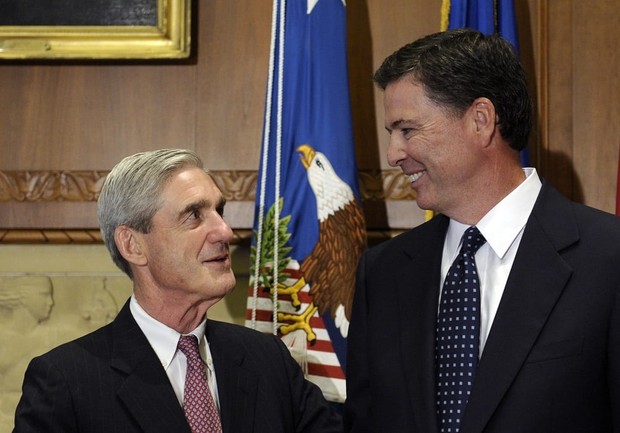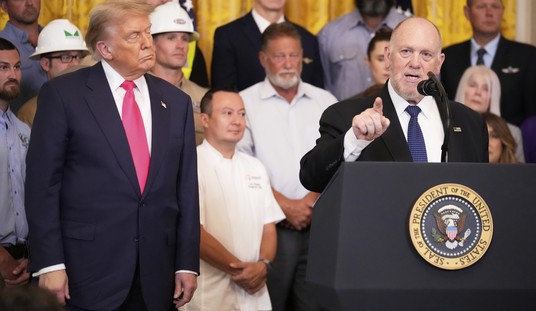
FILE – In this Sept. 4, 2013, file photo, then-incoming FBI Director James Comey talks with outgoing FBI Director Robert Mueller before Comey was officially sworn in at the Justice Department in Washington. On May 17, 2017, the Justice Department said it is appointing Mueller as special counsel to oversee investigation into Russian interference in the 2016 presidential election. (AP Photo/Susan Walsh, File)
It’s safe to say that most Americans didn’t read the Mueller Report, let alone the footnotes.
Real Clear Investigation’s Eric Felten actually did read the footnotes, all 2,000 of them, and they tell an interesting story indeed. In fact, Felten writes that it is in the footnotes “where the strengths and weaknesses of the Mueller report are most clearly on display.” After reading his report, I believe him.
Although the Mueller team had no time restraints, unlimited financial resources, nearly unfettered access to documents and interviews and all those high-powered Democrats, close scrutiny reveals that its end product, the Mueller report, is a unsubstantive, highly partisan document.
The first major observation is how heavily Mueller and his team relied on former FBI Director James Comey’s “memos.” You may recall, Comey had been in the habit of writing down notes of what had been discussed during his meetings and phone calls with President Trump because he didn’t trust him. Felten found that dozens of footnotes were based upon these one-sided accounts. He writes:
These include memos dated Jan. 7 and Jan. 28, 2017, as well as notes from Feb. 14, March 30 and April 11. Those memoranda were treated as the evidentiary gold standard by Mueller. Long stretches of the special counsel’s report hang almost exclusively on Comey’s say-so. One or another of Comey’s memos are cited some three dozen times in Volume II alone, which addresses possible obstruction by Trump.
There are many citations from an FBI interview of Comey as well as from Comey’s testimony before Congress in June 2017, after he had been fired.
As it turns out, Comey was far from an objective party throughout this political Peyton Place. In fact, if Real Clear Investigation’s Paul Sperry’s report is accurate, Comey was conducting a probe of President Trump while he assured him in person that he was not the subject of an investigation. This report, published on Monday, cited sources familiar with the DOJ IG investigation. It can be viewed here.
Regarding Comey’s bias, Felten writes:
Which means that Comey was writing his memos with an eye to swaying future legal and public opinion. Upon finishing a memo, he would run it by his top deputies (see footnotes 187 and 188 in Volume II) to make sure it served its purpose. Comey’s memos may or may not be the “strong corroborating evidence” Mueller claims, but Comey surely intended for those memoranda to establish his version of events.
This lack of skepticism about Comey’s motivation is especially jarring given footnote 544 in Volume II, which suggests a political motive and, perhaps, some lawbreaking. That’s where Mueller acknowledges that Comey arranged to have several of the aforementioned memos leaked: “Comey testified that he deliberately caused his memorandum documenting the February 14, 2017 meeting [with the president] to be leaked to the New York Times,” the footnote reads, “because he thought sharing the memorandum with a reporter ‘might prompt the appointment of a special counsel.’”
Equally disturbing were the numerous citations from media accounts of events. Mueller and his team were particularly fond of The New York Times and The Washington Post.
For example, the report states, “On July 22, 2016, the day before the Democratic National Convention, WikiLeaks posted thousands of hacked DNC documents revealing sensitive internal deliberations.” According to the footnote, this information comes from a Washington Post article written by Tom Hamburger and Karen Tumulty. It was entitled “WikiLeaks releases thousands of documents about Clinton and internal deliberations.”
In another example, the report states, “On December 10, 2016, the press reported that U.S. intelligence agencies had ‘concluded that Russia interfered in last month’s presidential election to boost Donald Trump’s bid for the White House.’” The footnote cites an article in The Guardian, which cites articles in the New York Times and the Washington Post. The newspapers each cite “anonymous sources.”
So, the source of this “factual” material in the Mueller report was anonymous and thrice removed.
Felten found that the report referenced many primary sources, such as FBI interviews, however, much of this material was opinion rather than evidence. For example, a footnote indicates that former National Security Advisor Michael Flynn
“told White House officials that the FBI had told him that the FBI was closing out its investigation of him,” but that John Eisenberg, a deputy White counsel, “did not believe him.”
Let’s pause for a second and consider what the footnote appears to tell us, but doesn’t: Eisenberg’s incredulity aside, did the FBI tell Flynn it was closing out its investigation of him or didn’t it? By citing Eisenberg’s disbelief, the special counsel suggests that Flynn was lying to his fellow White House officials. But what Eisenberg believed settles nothing – he was in no position to know what the FBI had or had not told Flynn.
What about the two FBI agents (one of them the ubiquitous Peter Strzok) who interviewed Flynn? The special counsel could have questioned them separately, asking each under oath whether they had told, suggested, hinted, or in any other way made Flynn to believe he was off the hook. In this case, the sources Mueller chooses not to question are more telling than the ones he does cite.
Although the Mueller report is one of the most important political documents in recent memory, it was written by a team of Democrats, many of whom were large donors, and it relied upon the most biased sources such as Comey, The New York Times, The Washington Post and The Guardian.
And still, they found no evidence of a crime.
When the report is carefully scrutinized, we wonder why we ever gave it so much attention.
We also have to question why this investigation, if one can even call it that, took 22 months.
After all, what did they have to investigate?














Join the conversation as a VIP Member